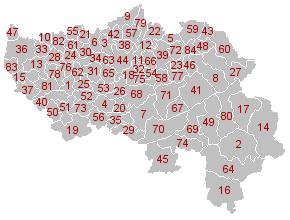
Flemish Brabant is a province of Flanders, one of the three regions of Belgium. It borders on the Belgian provinces of Antwerp, Limburg, Liège, Walloon Brabant, Hainaut and East Flanders. Flemish Brabant also surrounds the Brussels-Capital Region. Its capital is Leuven. It has an area of 2,118 km2 (818 sq mi) which is divided into two administrative districts containing 65 municipalities. As of January 2019, Flemish Brabant has a population of 1,146,175.
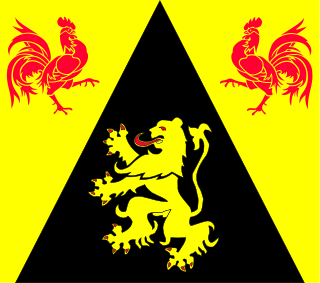
Walloon Brabant is a province of Wallonia and Belgium. It borders on the province of Flemish Brabant and the provinces of Liège, Namur and Hainaut (Wallonia). Its capital and largest city is Wavre.

The Walloon Region, usually simply referred to as Wallonia, is one of the three Regions of Belgium—alongside Flanders and Brussels.
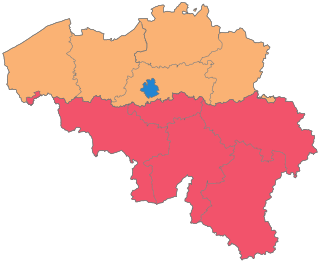
The country of Belgium is divided into three regions. Two of these regions, the Flemish Region or Flanders, and Walloon Region, or Wallonia, are each subdivided into five provinces. The third region, the Brussels Capital Region, is not divided into provinces, as it was originally only a small part of a province itself.
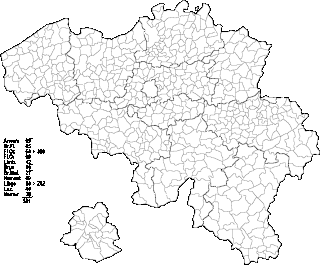
Belgium comprises 581 municipalities grouped into five provinces in each of two regions and into a third region, the Brussels Capital Region, comprising 19 municipalities that do not belong to a province. In most cases, the municipalities are the smallest administrative subdivisions of Belgium, but in municipalities with more than 100,000 inhabitants, on the initiative of the local council, sub-municipal administrative entities with elected councils may be created. As such, only Antwerp, having over 500,000 inhabitants, became subdivided into nine districts. The Belgian arrondissements, an administrative level between province and municipality, or the lowest judicial level, are in English sometimes called districts as well.

Sint-Genesius-Rode is a municipality located in Flanders, one of three regions of Belgium, in the province of Flemish Brabant. The municipality comprises the town of Sint-Genesius-Rode only, and lies between Brussels and Waterloo in Wallonia. On January 1, 2008, the town had a total population of 18,021. The total area is 22.77 square kilometres (8.79 sq mi), which gives a population density of 791 per square kilometre (2,050/sq mi).
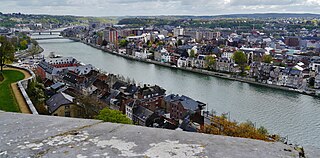
Namur is a city and municipality in Wallonia, Belgium. It is both the capital of the province of Namur and of Wallonia, hosting the Parliament of Wallonia, the Government of Wallonia and its administration.
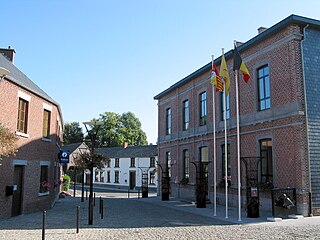
Burdinne is a municipality in Liège Province, Belgium. It lies in the country's Wallonia region. On January 1, 2006, Burdinne had a total population of 2,824. The total area is 32.57 km² which gives a population density of 87 inhabitants per km².

Hamoir is a municipality in Liège Province, Belgium. It lies in the country's Wallonia region. On 1 January 2006, Hamoir had a total population of 3,592. The total area is 27.80 km² which gives a population density of 129 inhabitants per km². Hamoir is situated on the river Ourthe.

Marchin is a municipality in Liège Province, Belgium. It lies in the country's Wallonia region. On January 1, 2006, Marchin had a total population of 5,114. The total area is 30.00 km² which gives a population density of 170 inhabitants per km².
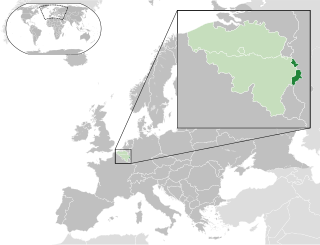
The German-speaking Community of Belgium or Eastern Belgium is one of the three federal communities of Belgium. Covering an area of 854 km2 (330 sq mi) within the Liège Province in Wallonia, it includes nine of the eleven municipalities of Eupen-Malmedy. Traditionally speakers of Low Dietsch, Ripuarian, and Moselle Franconian varieties, the local population numbers 77,949 – about 7.0% of Liège Province and about 0.7% of the national total.

The Flemish Region, usually simply referred to as Flanders, is one of the three regions of Belgium—alongside the Walloon Region and the Brussels-Capital Region. It occupies the northern part of Belgium and covers an area of 13,625 km2 (5,261 sq mi). It is one of the most densely populated regions of Europe with around 490/km2 (1,300/sq mi).

There are 27 municipalities with language facilities in Belgium which must offer linguistic services to residents in Dutch, French, or German in addition to their single official languages. All other municipalities – with the exception of those in the bilingual Brussels region – are unilingual and only offer services in their official languages, either Dutch or French.

The Belgian provincial, municipal and district elections of 2006 took place on Sunday 8 October 2006. The electors have elected the municipal councillors of 589 cities and towns as well as the ten provincial councils. The voters in the town of Antwerp have also been able to vote for the city's district councils. In seven Flemish municipalities with a special language statute and in the Walloon municipality of Comines-Warneton the aldermen and the members of the OCMW/CPAS council have also been directly elected.

Ultratop is an organization which generates and publishes the official record charts in Belgium. Ultratop is a non-profit organization, created on the initiative of the Belgian Entertainment Association (BEA), the Belgian member organization of the International Federation of the Phonographic Industry. Two parallel set of charts are concurrently produced and published, one on behalf of Belgium's mainly Dutch-speaking Flanders region, and the other catering to the nation's mainly French-speaking region of Wallonia.
Water supply and sanitation in Belgium is provided by a large variety of organizations: Most of the 581 municipalities of Belgium have delegated the responsibility for water supply and sanitation to regional or inter-municipal utilities. There are more than 62 water supply utilities, including 2 regional, 30 inter-municipal and 30 municipal utilities. Another 100 mostly small municipalities provide services directly without having a legally of financially separate entity for water supply. Water is not scarce in Belgium and water supply is generally continuous and of good quality. However, wastewater treatment has long lagged behind and Brussels only achieved full treatment of its wastewater in 2007. In 2004 the European Court of Justice ruled condemning Belgium's failure to comply with the EU wastewater directive, and the ruling has not been fully complied with so far. Wallonia satisfies 55% of the national needs in drinking water while it counts only 37% of the population. Flanders and Brussels are dependent on drinking water from Wallonia, at a level of 40% and 98% respectively.

Fagnolle Castle is a castle located in the district of Fagnolle, in the municipality of Philippeville, Wallonia, Belgium, and in the Fagne region. The castle was formerly the centre of government of the small independent Barony, later County, of Fagnolle. It was constructed in the 12th century, and is now ruined.

The Reichsgau Wallonia was a short-lived Reichsgau of Nazi Germany established in 1944. It encompassed present-day Wallonia in its old provincial borders, excluding Comines-Warneton but including Voeren. Eupen-Malmedy and Moresnet were also omitted, both of which had already been incorporated into Germany after its victory in the Battle of France in 1940.

The Belgian provincial, municipal and district elections of 2012 took place on 14 October. As with the previous 2006 elections, these are no longer organised by the Belgian federal state but instead by the respective regions:



